Daria Manshina Conduct Keyword and Backlink Competitor Analysis with SEMrush 98 Wow-Score The Wow-Score shows how engaging a blog post is. It is calculated based on the correlation between users’ active reading time, their scrolling speed and the article’s length. Learn more Conduct Keyword and Backlink Competitor Analysis with SEMrush
- 165
- 15
- 14
- 7
Having a well-optimized site is great, but it won’t remain so forever. You have to work continuously to stay on top. But it is impossible if you don’t know what your competitors are doing to try to outrank you on SERPs. Trust me; they are keeping an eye on you, so you need to do the same.
How can you analyze your competitors?
First, you need to identify them. A great place to start is to review who you are competing with for organic and referral traffic. Organic traffic competitors are pretty easy to spot: you can see them in the SERPs by googling your target keywords. Of course, you can’t google every keyword if you have a lot of them. And it is even more complicated with referral traffic, because who knows where to look for competitors’ backlinks?
But there is a workaround! Let’s look at how to do competitor analysis using the SEMrush toolkit. The post consists of two major parts:
Keyword competitor analysis
Backlink competitor analysis
Keyword Competitor Analysis
Even though you know most of your keyword competitors, there is a chance that you could have missed a dark horse and may be surprised when thrown from the high organic positions.
Catch ‘em all!
Before analyzing your enemies make sure you know them all. The SEMrush Keyword Competitors report will compile a full inventory for you: all the unexpected figures and still-not-too-well-known startups are all here.
To indicate how closely a domain competes with another one, we use a parameter called Competition level.
Your site’s Competition level depends on two things: how many ranking keywords your competitor has, and what percentage of them are your common keywords. For example, if you are a travel blog, Wikipedia won’t be your competitor because, in addition to all of the possible places and travel tips you have written about, it also ranks for billions of other keywords. Another travel blog, on the contrary, will be competing with you.
Pay special attention to those competitors whose site is competing with yours the most in terms of traffic and total keyword numbers.

After you have made a list of rivals it is time to look closer at them. Here are a few tips that can help you beat your competitors with keywords.
Check How They Are Doing
Let’s start with analyzing a potential weak point for your competitor and a place you could easily conquer; your competitor’s new and lost keywords. Their new keywords may show you that the niche they are entering is new. In this case, it is probably not fully taken yet. Their lost keywords might show you that they were penalized and lost their positions, so there could be some free space for you and your site.
You can find all this information in the Position changes report. Spikes on the graph let you learn about sudden changes in your competitors’ actions. By selecting a spike and sorting the results e.g. by position, you will learn what keywords have undergone the most changes.

Hijack Their High-Volume Keywords
The second step after you know how your competitors are doing is to look closely at how your and their keywords are different. For example, you can take a look at the keywords that are unique for your competitor. Maybe you missed them when writing your content. SEMrush can help you identify them.
The Keyword Gap report shows you keywords that only your competitor has.

After you have your list, you can apply a few advanced filters. Find where they are ranking in low positions in the SERPs for relevant keywords and aim for beating those rankings with your content. If they are stuck on the 2nd page you can always aim for the 1st and gain more visibility in the SERPs.
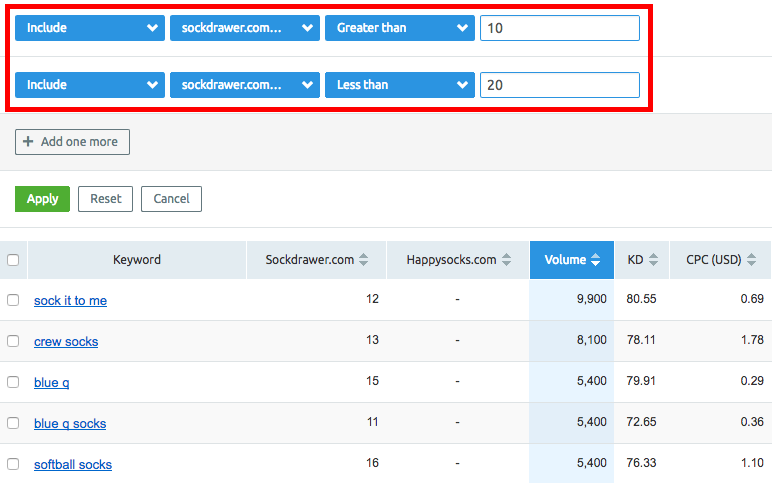
Research Your Common Keywords
The third step is to research the words that both you and your competitor have in common. You can also find these in the Keywords Gap report.

Now, by applying advanced filters, find the keywords that your competitor ranks higher for than you and make a list of those. These are keywords that need your attention right now.
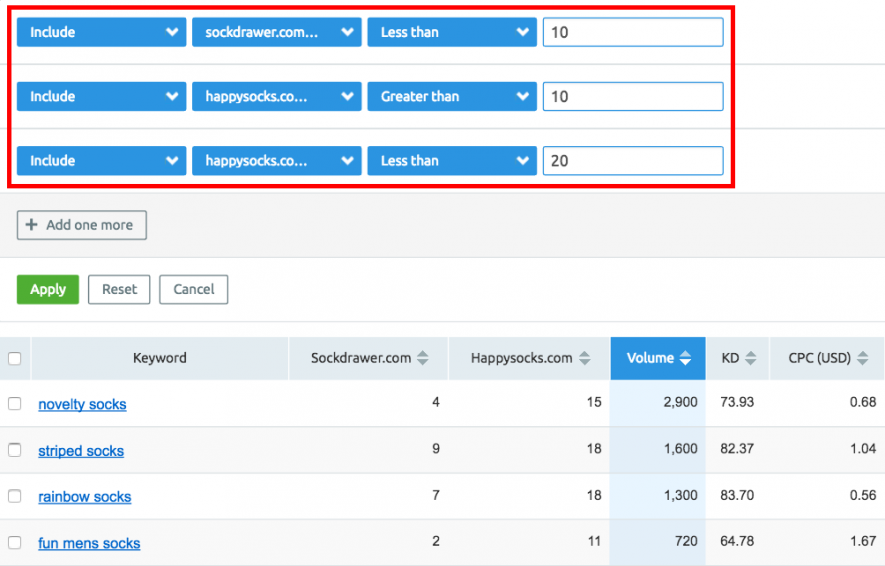
Export Your Keywords
It is important to follow the positions of the keywords you choose. To do that, you can add as many of the picked words to the Export Manager as you want. Later on, upload the exported .csv or .xls document to the Position Tracking instrument to track how their positions are changing.

Get More Specific
In order to learn what types of content prove most successful in organic results and to get a better understanding of your future content strategy go to the Pages report. It will show you the percentage of traffic that a specific URL of your competitor's domain gets and the number of keywords on the page.

If you really love keyword research, you can dive even deeper into the date to help improve your content drastically. To learn some tricks about conducting deeper keyword research, read our recent article on how to do it using the SEMrush Keyword Magic Tool.
Backlink Competitor Analysis
Studying your backlink competitors helps you gather new ideas for your own link building strategy. Take a careful look at your competitors’ profiles and make a list of domains on which they have already placed their high-quality backlinks.
Gather Your Backlink Competitors
Just like with keywords, you have to make a list of your competitors before analyzing each of them. The SEMrush backlink Competitors report shows you all you rival domains, along with their Сompetition level. The higher their percentage of common backlinks from the whole domain’s backlink profile, the higher your Сompetition level will be. This report also shows you their total number of backlinks and referring domains.

Obviously, the higher a competitor’s competition level is, the more relevant they are for further analysis. But don’t only focus on this number. Another important characteristic is the backlink/domain ratio. It can show you whether your competitor makes emphasis on building high-quality organic links, or if they resort to gray methods.
Find High-Quality Referring Domains
In the long run, you have to follow what your competitors are doing in order to get new ideas for your own link-building strategy.
It is important, as you know, to not only get as many links as possible but also to make sure their sources are diverse. So, choosing one from the competitor list, go to the Referring Domains report and get a list of domains that link to this specific competitor.
By sorting these domains out by trust score, you can make a list of domains you most probably want to contact to improve your backlink profile. Just make sure they are relevant for your sphere.
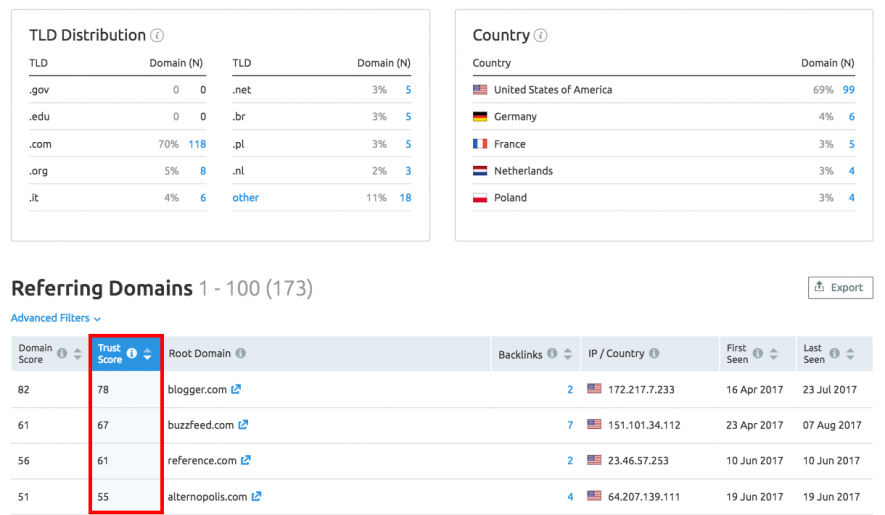
Also, make sure that all these backlinks do not come from the same domain; you would not want to get penalized by Google.
Analyze Drastic Changes
To avoid missing any shifts in your competitor’s backlink positions check the Backlinks report. It will show you all recent changes in their backlink profiles. If you see a “New” spike, check it out. One possibility is that your competitor got a new partnership, uploaded new content that went viral, or just bought a bunch of links.
By checking “Lost” spikes you can find a whole list of domains to contact and place your links on.
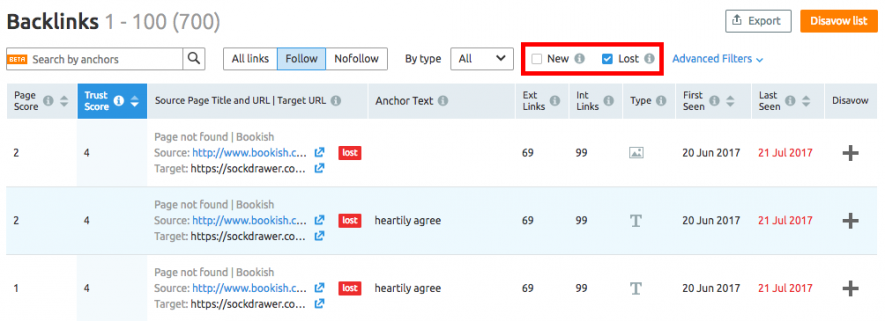
Dig Deeper
The Indexed Pages report will let you know which URLs on a competing domain are most popular for linking. Studying the URLs with the most backlinks and linking domains can help you understand how to make your content as attractive to the external sources. For example, has your competitor found a new popular content format? Or do they know what type of content is often referred to in their niche? Find out!
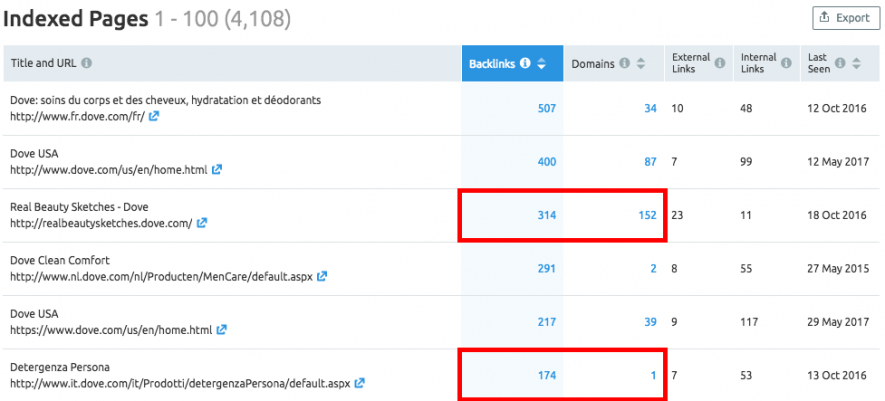
Fill In the Gaps
There are always some domains that have a lot of backlinks to your competitor but not to you. To create a full list, use the Backlink Gap report. Besides the domain comparison, it provides the comparison by specific URLs in case you need to compare pages with similar content.
In this report, filter your competitor’s referring domains and make a list of trusted sites on which your links could be placed safely.

Fin
Now that you have discovered a plethora of information about your competitors’ actions, you are ready to begin your journey to a new SEO quest.
Have any tips for competitor analysis? Share them with us in the comments!
Discover SEMrushRead the original article here



